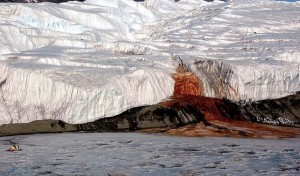When I think of Antarctica, I think of a serene landscape of frigid air and a slick, icy ground. However, this image completely changed my initial visualization of Antarctica completely. The rich red liquid descending down the Arctic tundra stirs confusion around the stereotypical white icebergs. What causes this bloody river?
This is appropriately called Blood Falls and is located in the McMurdo Dry Valley region of Antarctica. It is nearly five stories high, flows from 7.5 miles inland to the coast, and is one of the coldest and most inhospitable places on Earth; scientists like to compare to the cold, dry deserts of Mars. Jill Mikucki, a geomicrobiologist at the University of Tennessee, Knoxville, discovered a possible cause for Blood Falls in 2009 that continues to be the best explanation for this mystery. The falls are actually a brine, mixed with iron from the bedrock below. As bacteria slowly chew the rock, the iron is released into the brine. The salt water and iron combination creates the distinct, bloody rust color when it mixes with oxygen as it reaches the surface.
The tests of her team showed that the waters of Blood Falls contains almost no oxygen and holds a community of at least 17 different types of microorganisms. This is thought to be flowing from a lake trapped beneath the ice for about 2 million years and may be over three miles deep. Now, Mikucki’s work in this area confirms zones of liquid salt water hundreds of meters below Blood Falls. This underwater zone seems to be the home of a hidden ecosystem of microbial life, which allows scientists to question whether a similar ecosystem could exist on Mars.
This idea spawned a continuation project for Mikucki and her team to further explain Blood Falls and its further represent the potential for life on Mars. Mikucki and her team discovered three main pieces of evidence. First, a genetic analysis of the microbes showed that they were closely related to other microorganisms that use sulfate instead of oxygen for respiration. Second, isotopic analysis of the sulfate molecule’s oxygen atoms revealed that the microbes were modifying sulfate in some form but not using it directly for respiration. Third, the water was enriched with soluble ferrous iron. This would only happen if the organisms had converted insoluble ferric iron to the soluble ferrous form. The best explanation is that the organisms use sulfate as a catalyst to ‘breathe’ with insoluble ferric iron and metabolize the small amounts of organic matter trapped with them years ago. Lab experiments suggested this might be possible, but it never been observed in a natural environment.
“Blood Falls is the only known surface manifestation of these deep brine systems and has been shown to contain a viable ecosystem with numerable microbial cells,” the researchers of Mikucki’s team wrote in their study, “Blood Falls reveals how microbial metabolism can release iron from underlying bedrock, which is ultimately discharged to the surface or below ground to Lake Bonney.” These discoveries may represent not only how life may appear on Mars, but some of the frozen moons of Jupiter as well, which may contain subsurface liquid water.
http://earthsky.org/earth/blood-falls-five-stories-high-seeps-from-an-antarctic-glacier
http://www.huffingtonpost.com/2015/04/29/antarctica-blood-falls_n_7168104.html

This is another awesome place that you found. Every week, you really intrigue me with your interesting finds. I think it’s truly amazing how a place with no oxygen complexes can create an environment sustainable for more than 17 microorganisms. In addition, I think this is a perfect example of how we can observe the world around us to make improvements, discoveries, and creations for the future; the Mars correlation being an example. For years we have been told that Mars has a sustainable environment that can hold species and even human life. However, with this discovery and interpretation, we can be inspired to create new investigations to prove that point.
Wow. Yet another great blog about a truly mystifying and beautiful phenomenon. I think that the variation and variety of life in on the microscopic level is amazing. You write in a way that makes reading about the science behind something beautiful fun. Although I’m not sure that this is one of my top places to potentially visit, I think it’s super interesting how this is occurring in nature. Good job and keep on keeping on.
The diversity of life on the microscopic level is phenomenal. The fact that these organisms not only figured out a way to survive in subzero temperatures, but also a means undergoing respiration by utilizing inorganic compounds such as ferric iron and sulfate as the source of energy that drives its metabolism. Not only that, but the fact that this Blood river exists further provides evidence that Mar’s environment may be similar to that of the Earth’s a few billion years ago. This makes me wonder if Mars will ever develop into what Earth is today?
This is another very cool natural phenomenon. However, this is the first of your blogs that contains a natural oddity that I would not want to witness in person. Antarctica is way too cold and far away, and I honestly have no business there. It is crazy that this environment is comparable to that of another planet. The research being conducted on Blood Falls is really cool, and I would love to know both what microorganism is responsible for this and if life on Mars is a thing. Overall, great blog and keep up the good work.
Other than all of the biological jargon that I tried to follow, the concept of Blood Falls is truly spectacular. The immense height of the phenomenon and the complex chemical process simply blows my mind. I also find the fact that Blood Falls inhabits 17 different types of microorganisms incredible. I’m very glad I ran across this post last week so I can read about unique places around the world.